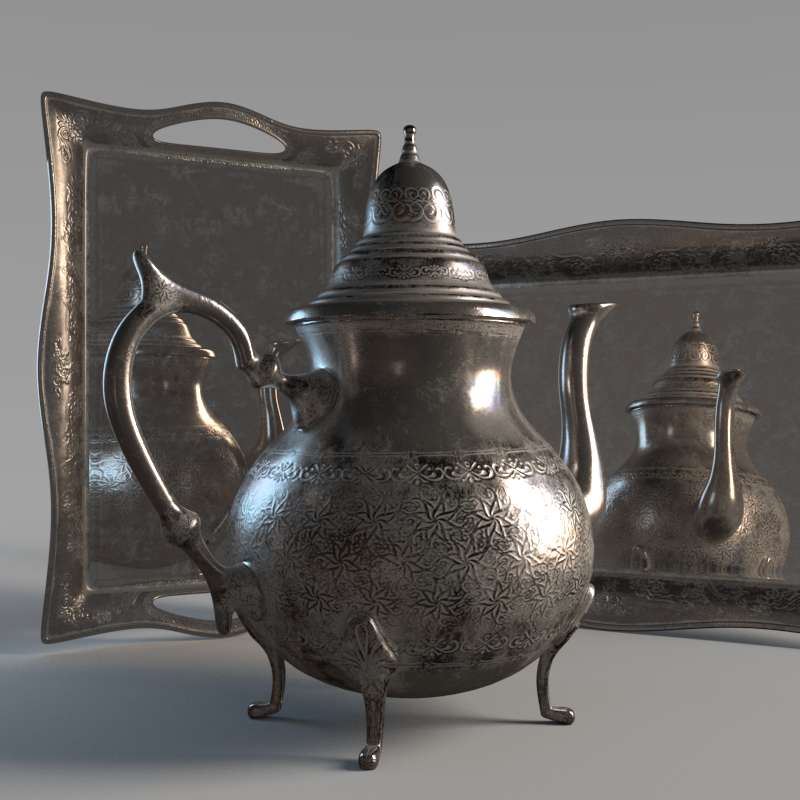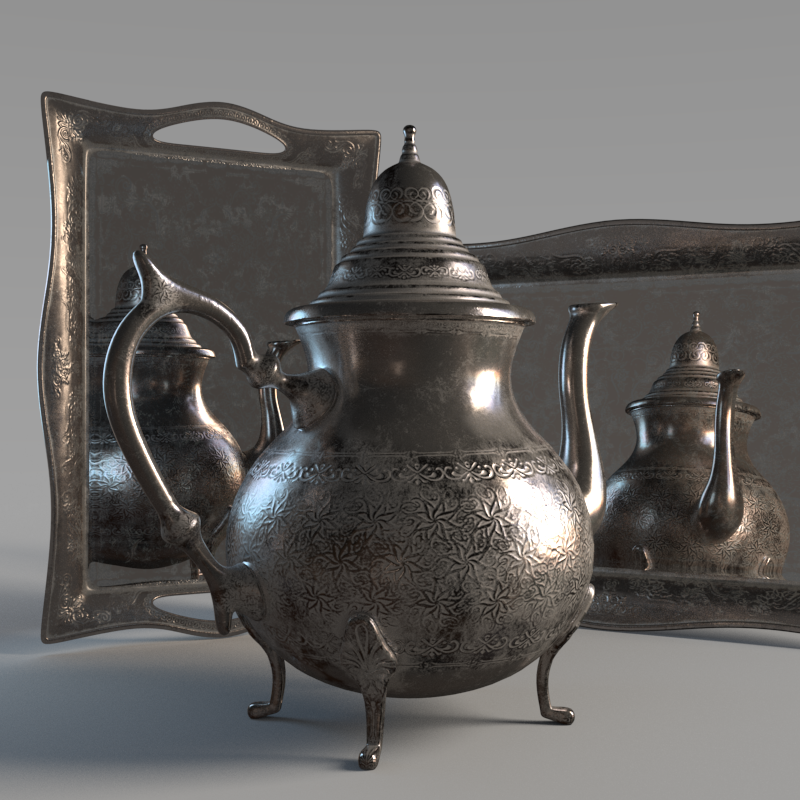This page provides a tutorial for rendering, using the Environment Priority settings.
Overview
In this tutorial, we will examine ways to efficiently render a scene with several objects whose environment maps have different environment priorities.
First, we will show a rendered scene with three different objects (a teapot and two trays) where a single global environment map is set.
Second, we will assign environment maps to the objects to demonstrate how their reflections change, compared to the first render when they reflect the global environment map. Then, we will analyze how the objects appear in the rendered image based on the environment priority they are assigned. We want to efficiently render several views of the scene, using the Environment Override and Environment Priority.
The Environment Priority is just the precedent of one override over another when one overridden material is reflected in another overridden material, then in another and so on. The priority number starts from 0 for the lowest priority and increases, where >1 stands for higher priority. For further information on the concept of environment priority, see the Environment Priority page.
Want to follow along but don’t have a license?
Step 1: Set the Global Environment Map
Let's start by selecting a map. Assign it as an Environment Map for the whole scene.
This can be done by drag-and-dropping the map from the Material Editor to the Environment Map slot in the Environment and Effects dialogue.
To open the dialogue, go to Rendering > Environment.
Here is the rendered image of the scene, where we use a Gradient map as a global environment map. No environment override/priority is assigned and all the objects reflect the Gradient map.
Notice how the reflections from the global environment seen in the three objects are not very appealing. They are very bright and merge with the background.
We can change the reflections by assigning environment maps to each object, thus overriding the global environment.
Step 2: Set the Objects Environment Maps
Let's assign different texture maps to the environment override materials of the teapot and the two trays. This is done in the Material Editor > Material/Map Browser > Maps > V-Ray > V-Ray Bitmap.
Connect the texture maps to the Environment slots of the respective materials.
First, we assign a texture map only to the teapot.
This way we override the global environment in the reflection of the teapot.
The teapot now stands out in the background. However, the reflections from the teapot's environment in the trays are too distinctive. In addition, the trays are not visible in the background, so this is not the result we are after.
Let's tackle that by assigning an environment map to the horizontal tray.
Now the reflection of the tray is more distinctive. However, the reflection from the environment of the teapot in the horizontal tray still does not look good. We want to soften its reflections.
To achieve a softer reflection, the environment priority option comes very handy. However, before moving to step 3, let's improve the reflection of the vertical tray as well.
In the image above, the environment reflected in the vertical tray was too light. So, we assign an environment override to the vertical tray as well.
Currently, each object uses the environment map that was assigned to its material for all reflections.
Let's examine the result. Although, the reflections of both trays are distinctive now, the reflection of the teapot environment in them still attracts too much attention. We need to soften the look. This can be corrected by assigning environment priorities to the environment textures of the trays.
Step 3: Setting Environment Priority
Once the environment maps are set, assign an environment priority to each object's environment map.
To do so, select the object's material and go to the Options rollout in the Parameters. Set the environment priority for each object.
Set a higher priority to the environment that you want to prevail over another.
Note that the global Environment Map is always considered with lowest priority. You can override it in the reflection of the scene's objects by assigning environment maps with higher priorities to their materials.
Result Render
The renders below show changes in the reflection of the teapot and the trays, depending on the environment priority value we set. The texture map with the highest priority (2) overrides the global Environment map (which is a Gradient map in this case) as well as the Environment maps of the objects with lower environment priorities 1 and 0. This can be seen in the reflections of the objects with lower environment priorities.










